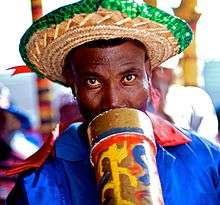Rara
| Music of Haiti | |
|---|---|
| General topics | |
| Related articles | |
| Genres | |
| Media and performance | |
| Music awards | Haitian Music Award |
| Music festivals | |
| Nationalistic and patriotic songs | |
| National anthem | La Dessalinienne |
| Regional music | |
| |
Rara is a form of festival music that originated in Haiti, that is used for street processions, typically during Easter Week. The music centers on a set of cylindrical bamboo trumpets called vaccine, but also features drums, maracas, güiras or güiros (a percussion instrument), and metal bells, as well as sometimes also cylindrical metal trumpets which are made from recycled metal, often coffee cans. The vaccine perform repeating patterns in hocket and often strike their instruments rhythmically with a stick while blowing into them. In the modern day, standard trumpets and saxophones may also be used. The genre though predominantly Afro-based has some Taino Amerindian elements to it such as the use of güiros and maracas.

The songs are always performed in Haitian Creole and typically celebrate the African ancestry of the Afro-Haitian masses. Vodou is often implemented through the procession. The genre was imported to the Dominican Republic and is now an integral part of the Afro-Dominican music scene, where it is known colloquially as gagá.[1] In the Dominican Republic, the music is often played by the Afro-Dominican population as a cultural tribute to their African ancestors in the same manner as their counterparts in Haiti. Rara in Haiti is often used for political purposes, with candidates commissioning songs praising them and their campaigns. Rara lyrics also often address difficult issues, such as political oppression or poverty. Consequently, rara groups and other musicians have been banned from performing and even forced into exile—most notably, folk singer Manno Charlemagne who later returned to Haïti and was elected mayor of Port-au-Prince in the 1990s.
Rara performances are often performed while marching and are often accompanied by twirlers employing metal batons. Performances generally begin on Ash Wednesday and culminate at Easter Weekend.
Rara was also an important part of a slave's daily lives. Working in the fields, and plantation of endless crops, was agony. And at the end of the day, rara's would take place in the streets, to show how good they were still doing, even after such hard and meaningless work. After Haiti's independence, rara bands took the streets by storm to celebrate, the victory. The war won. The Rara festival is likely to have developed during the period of colonial slavery. There is evidence that African and Afro-Creole slaves in the French colony of Saint-Domingue paraded with drums and instruments on Easter Sunday. There is also some evidence that troupes of maroons marched with drummers, horns, and singers, similarly to Rara.[2]

Since the 1990s, Haitian Americans have been performing Rara in New York City's Prospect Park in the summer on Sundays.[3]
References
- McAlister, Elizabeth. Rara! Vodou, Power, and Performance in Haiti and its Diaspora. Berkeley: University of California Press, 2002. Book on Rara in Haiti and New York City.
Citations
- ↑ Manuel, Peter with Kenneth Bilby, Michael Largey (2006). Caribbean Currents: Caribbean Music from Rumba to Reggae. p. 156. Retrieved 29 January 2014.
- ↑ Shepherd, John; Horn, David (2014). Encyclopedia of Popular Music of the World, Volume 9, Genres: Caribbean and Latin America. London: Bloomsbury. p. 447. ISBN 9781441141972.
- ↑ Learning website on Rara
See also